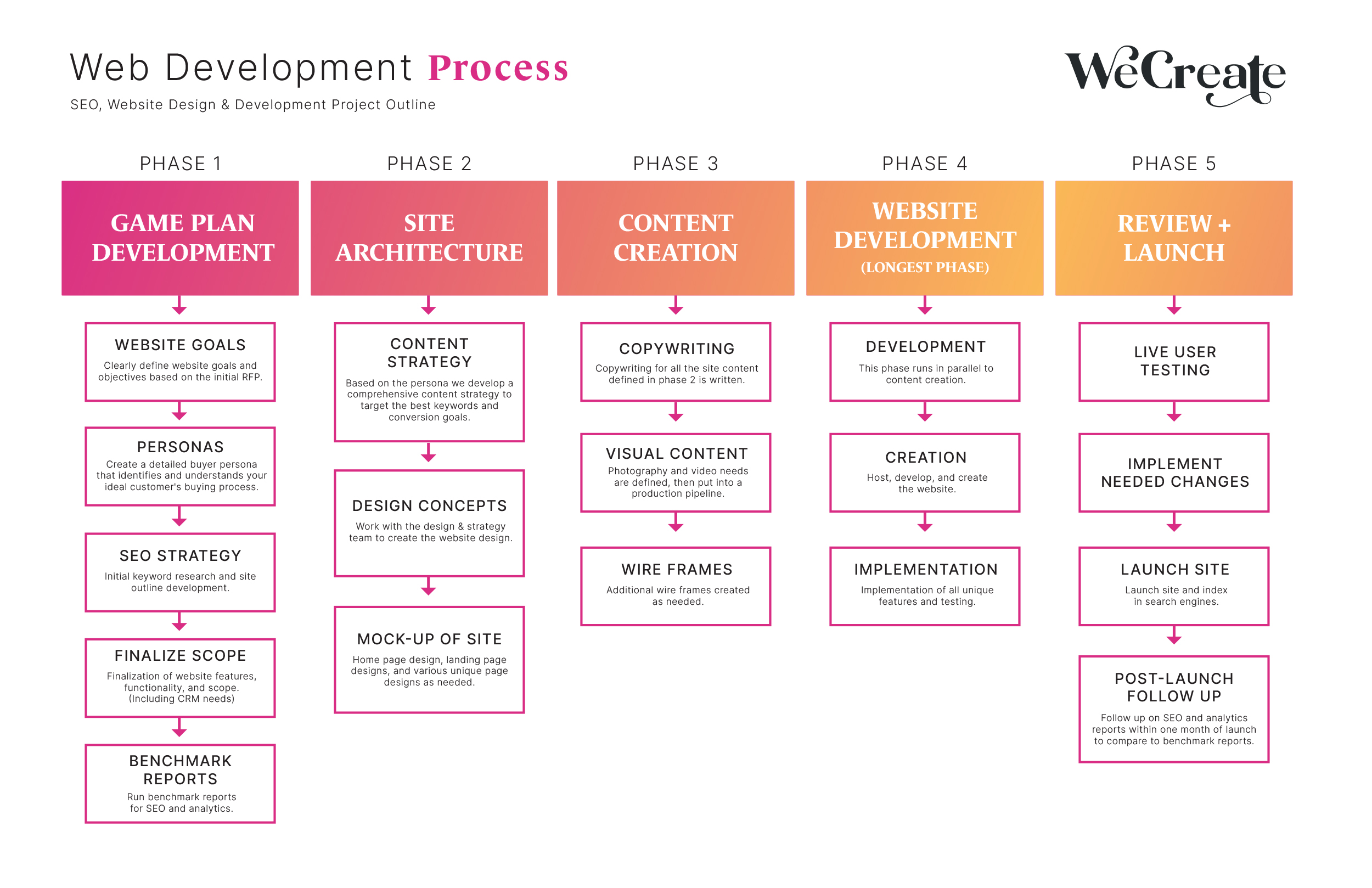Strategic web design strategies to upgrade navigation and usability
All Regarding Website Design: Understanding Its Importance for Your Online Presence
Website design functions as an essential element of developing an on the internet presence. It affects customer experiences and shapes understandings of brand names. Efficient website design integrates different aspects that boost use and involvement. As the digital landscape advances, comprehending the significance of these layout principles ends up being important (web design). What are the vital elements that make an internet site not simply useful, yet compelling? Discovering this might reveal crucial understandings for any individual intending to do well online
The Function of Website Design in Individual Experience
Website design exceptionally affects customer experience by forming just how site visitors interact with a website. Components such as format, color pattern, and typography create the impression, guiding customers via the content. Effective web style focuses on intuitive navigating, ensuring that visitors can easily discover information without frustration. Receptive style boosts access throughout numerous devices, catering to a more comprehensive target market. The rate of a web site likewise plays an important role; slower-loading web pages can result in greater bounce prices and lowered user satisfaction. Aesthetic pecking order, accomplished via spacing and dimension modifications, routes customers' interest to vital functions or calls to activity. Consistency in style components cultivates knowledge and trust, motivating individuals to engage more deeply. Eventually, a well-designed internet site not only brings in site visitors yet likewise retains them, affecting their overall assumption of the brand or service it represents. In this way, website design is a fundamental element of a successful on-line existence.
Crucial Element of Reliable Website Design
Efficient internet style depends upon numerous key aspects that boost user involvement and complete satisfaction. Aesthetic pecking order principles assist individuals through material, guaranteeing that important info attracts attention - web design. Mobile responsiveness is crucial in an electronic landscape where users gain access to internet sites throughout different tools.
Aesthetic Power Structure Principles
Many components contribute to a successful website, the concepts of aesthetic pecking order stand out as foundational to guiding customer experience. Visual hierarchy refers to the setup of style elements to connect importance and straight individuals' attention efficiently. Key factors consist of size, color, contrast, and spacing, which aid focus on info and create a flow that is instinctive for users. Larger elements commonly attract the eye initially, while contrasting colors can highlight contact us to action. Thoughtful spacing can additionally enhance readability and understanding. By applying these principles, developers can craft a smooth experience that not just engages individuals however additionally promotes navigation and boosts total usability. Inevitably, a well-executed visual power structure improves the site's efficiency in sharing its message.
Mobile Responsiveness Fundamentals
Mobile responsiveness is a vital component of modern website design, guaranteeing that websites operate flawlessly across various devices and screen dimensions. This flexibility boosts user experience, as visitors can access material easily whether they utilize a tablet, desktop, or smart device . Crucial element of mobile responsiveness include fluid grids, flexible pictures, and media inquiries, which permit layouts to readjust dynamically. Prioritizing touch-friendly navigating and readable typography even more boosts functionality on smaller displays. Furthermore, optimizing loading rates is essential, as mobile users often anticipate fast access to info. By carrying out these basics, internet designers create sites that engage customers, reduce bounce prices, and inevitably contribute to enhanced conversions and consumer complete satisfaction. Mobile responsiveness is thus essential for preserving an affordable on-line visibility.
The Influence of Website Design on Brand Understanding
Internet design significantly influences brand name assumption, beginning with the important impression a website makes on visitors. Constant aesthetic elements boost depend on and acknowledgment, strengthening the brand name's identification. In addition, a positive customer experience can shape how customers involve and watch with the brand name in general.
Initial Impressions Matter
Their preliminary reaction can substantially affect their understanding of the brand when site visitors encounter a web site. A well-designed website can stimulate feelings of professionalism and trust, dependability, and trust fund, while an inadequately constructed one may set off suspicion and uncertainty. Individuals often create judgments within seconds, making the first impact crucial. Elements such as design, shade schemes, and typography play substantial duties fit these initial ideas. A tidy and modern-day design can share technology, whereas obsolete visuals may suggest forget. In addition, an intuitive navigation system improves customer experience, reinforcing favorable assumptions. Effective internet style not only captures focus but additionally develops a solid foundation for brand name identification, influencing ongoing relationships with visitors and potential clients.
Aesthetic Consistency Builds Depend On

User Experience Affects Perception
A natural aesthetic identity lays the foundation for a favorable customer experience, which significantly influences brand name perception. Efficient web style guarantees that customers can browse a site with ease, bring about higher contentment and engagement. They are a lot more likely to link the brand with professionalism and reliability and integrity when content individuals experience a cosmetically pleasing and functional internet site. Alternatively, bad design can result in frustration, causing users to form negative impacts. Aspects such as color systems, typography, and design play a necessary role fit psychological feedbacks. Inevitably, a properly designed internet site not only improves use but also enhances the brand name's worths and message, developing a lasting effect on customer perception and loyalty. Consistency in layout further strengthens this link, fostering count on and knowledge.
Look Engine Optimization and Web Layout
Efficient website design is necessary for enhancing search engine optimization (SEO), as it straight affects how online search engine creep and index an internet site. A well-structured site, including user-friendly navigation and clear hierarchies, enables internet search engine to quickly recognize the content and its significance. Additionally, the use of enhanced meta tags, headings, and alt message for photos further aids in improving visibility in internet search engine results.
Page tons rate, an important facet of web style, considerably affects Search engine optimization positions. Sites that pack gradually might irritate individuals, resulting in higher bounce rates, which internet search engine take a negative signal.
Including SEO ideal methods into internet layout not just boosts search engine positions yet likewise ensures that site visitors have a favorable experience. Eventually, a holistic strategy to website design and SEO can cause raised traffic, better individual interaction, and boosted conversion rates, making it important for on the internet success.
Responsive Design: Satisfying User Needs Across Tools
As customers significantly gain access to web sites from a variety of devices, responsive design has become a critical service for meeting their needs. This approach guarantees that web pages adjust seamlessly to different display alignments, dimensions, and resolutions, giving an excellent watching experience. By employing fluid grids, flexible photos, and media inquiries, responsive style allows material to range and reorganize, improving use across smartphones, desktop computers, and tablet computers.
Additionally, responsive layout enhances site performance, as it typically minimizes loading times through enhanced pictures and streamlined code. This efficiency not just enhances individual complete satisfaction but also contributes to far better search engine rankings, as online search engine favor mobile-friendly websites. As the electronic landscape remains to advance, services that prioritize responsive style are much better furnished to involve their target markets successfully, assuring that individuals can communicate and navigate with content despite the device they utilize. Subsequently, receptive design is necessary for maintaining a strong on the internet visibility.
The Relevance of Accessibility in Web Layout
Internet design not just calls for responsiveness to various tools however additionally demands a dedication to availability for all individuals. Accessibility in website design assurances that individuals with specials needs can browse, recognize, and communicate with online web content properly. This includes numerous elements, including message readability, alternate text for pictures, and key-board navigating choices. By focusing on access, internet designers produce comprehensive experiences that accommodate a diverse target market, consequently broadening their reach and improving individual complete satisfaction.
Furthermore, obtainable web sites can improve seo and decrease prospective legal threats connected with non-compliance to access standards. Businesses that welcome inclusive layout not only fulfill ethical obligations but likewise demonstrate social duty, fostering a favorable brand image. Ultimately, the relevance of ease of access in website design hinges on its ability to produce equitable on-line atmospheres, empowering all customers, despite their abilities, to engage completely with electronic material and services.
Patterns in Web Style: Remaining Current in a Digital Globe
Staying abreast of fads in website design is necessary for designers aiming to deliver appealing and modern-day user experiences. As modern technology develops, so do customer expectations, making it vital for designers to incorporate modern components into their job. Present patterns include minimalism, which prioritizes tidy lines and ample white space, boosting usability and aesthetic appeal. On top of that, the increase of dark mode alternatives accommodates user comfort while browsing.
Receptive style remains crucial, guaranteeing sites operate seamlessly across various devices. The integration of micro-interactions includes a layer of involvement, permitting address users to really feel a connection with the website. The usage of vibrant typography and vibrant color combinations can also help capture focus in a congested digital landscape. By accepting these patterns, web designers can create visually attractive, practical, and straightforward websites, inevitably reinforcing their customers' on-line visibility and fostering positive individual communications.
Regularly Asked Inquiries
How Much Does Specialist Website Design Commonly Cost?
Specialist website design generally costs in between $2,500 and $10,000, depending upon complexity and attributes. Personalized designs may increase costs better, while simpler design templates can minimize expenditures, making prices extremely variable based on Get More Information client needs.

Can I Design My Site Without Coding Understanding?
Yes, a person can develop a website without coding expertise. Many straightforward web site building contractors and content monitoring systems give design templates and drag-and-drop attributes, allowing individuals to create aesthetically appealing websites easily and successfully.
What Are Usual Mistakes to Stay Clear Of in Internet Style?
Usual blunders in website design include messy formats, bad navigation, absence of mobile optimization, disregarding user experience, slow filling times, making use of way too many fonts or colors, and ignoring accessibility. These mistakes can deter site visitors and decrease interaction.

Exactly how Usually Should I Update My Site's Style?
A site's design should be upgraded every 2 to three years, or sooner if substantial trends arise. Routine updates assure significance, improve individual experience, and keep compatibility with brand-new innovations and tools, fostering continuous interaction.
What Devices Can Aid Me Produce My Own Web site?
Various tools exist for developing web sites, including WordPress, Wix, and Squarespace (website design). These systems offer straightforward interfaces, adjustable layouts, and different attributes that empower people to develop web sites customized to their certain demands and choices
Web layout greatly influences user experience by forming just how visitors interact with a website. Reliable internet style hinges on several key components that improve customer involvement and contentment. Efficient internet style warranties that users can navigate a website with ease, leading to greater complete satisfaction and engagement. Staying abreast of trends in internet style is crucial for designers intending to supply contemporary and engaging customer experiences. Common blunders in web design consist of chaotic formats, poor navigating, lack of mobile optimization, disregarding customer experience, sluggish loading times, utilizing as well lots of font styles or shades, and neglecting access.